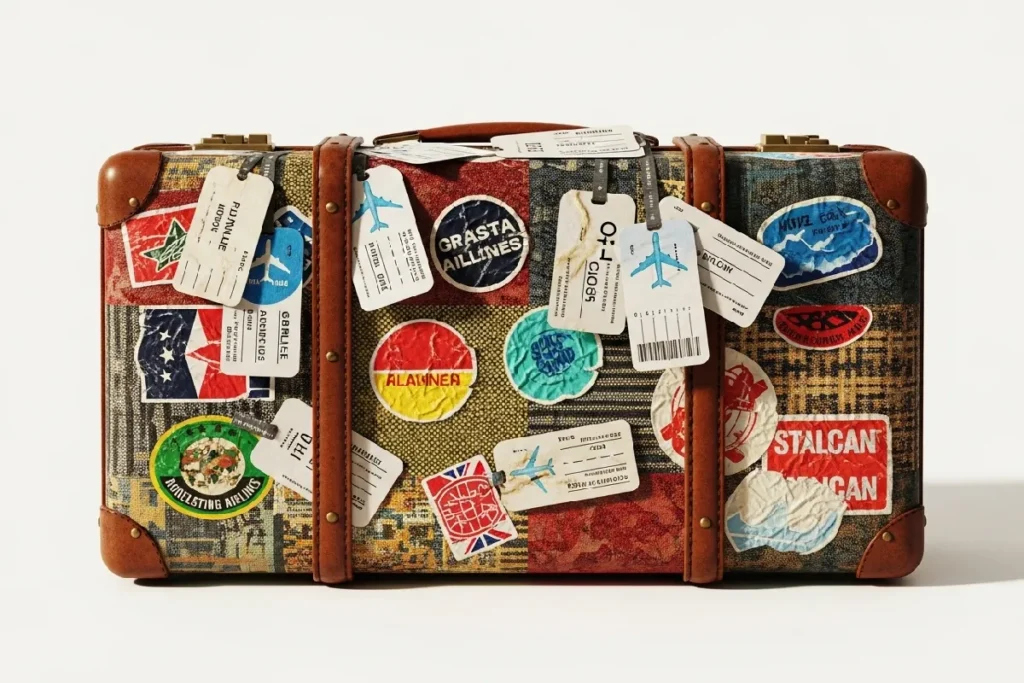Explore the fascinating evolution of the rolling suitcase, from its inception in the 1970s to its role as a symbol of personal identity and cultural significance in modern travel. This blog post delves into the transformation of luggage design, highlighting advancements in technology and materials, the impact of travel on personal narratives, and the broader implications related to migration and socioeconomic factors. Discover how the rolling suitcase not only enhances convenience but also reflects the diverse experiences and aspirations of travelers, making it a vital companion in the journey of exploration and self-discovery.
Table of Contents
Introduction to the Rolling Suitcase
The rolling suitcase, an indispensable travel companion for millions, has undergone significant transformation since its inception. Originally designed as a practical solution for transporting belongings, the rolling suitcase has evolved into a sophisticated item that reflects not only utility but also personal identity and status in the context of migration and tourism. Invented in the late 20th century, the design integrated wheels and an extendable handle, facilitating ease of movement that revolutionized the way travelers carry their luggage.
In its early days, the rolling suitcase was a novel invention that quickly gained popularity. Travelers appreciated the convenience it offered compared to traditional duffel bags or hard-shell suitcases that required lifting and carrying. The design catered to a growing demand for mobility, ushering in a new era of travel where ease and efficiency became paramount. The evolution of materials used in luggage construction further impacted its design and functionality. Lightweight, durable materials allowed for larger compartments without the burden of excessive weight, changing the packing habits of globetrotters and holidaymakers alike.
As society has progressed, so too has the rolling suitcase come to reflect the changing dynamics of travel classes and the travel class divide. What was once solely a functional item is now a statement piece, often chosen for its visual appeal and brand association. In this light, the cultural meaning of luggage extends beyond mere practicality; it serves as a symbol of one’s travel experiences and aspirations. The rolling suitcase embodies not only the act of travel but also the identity that each journey imparts. It encapsulates the stories, memories, and cultural significance that travelers carry, making its evolution an essential narrative within the broader discourse of tourism and identity.
The Invention of the Rolling Suitcase
The inception of the rolling suitcase can be traced back to the 1970s, when a visionary named Bernard Sadow, an American designer, recognized the inconvenience of traditional luggage and devised a practical solution. His innovative suitcase, which featured wheels and a telescoping handle, transformed the dynamics of travel as it allowed individuals to transport their belongings with ease, alleviating the physical burden that previously accompanied air travel and other forms of transportation.
Prior to this breakthrough, travelers had to struggle with heavy and unwieldy bags. The introduction of the rolling suitcase heralded a new era in the luggage evolution, as it ingeniously combined functionality with convenience. Initial reactions to Sadow’s invention were mixed; while some lauded it for its practicality, others were hesitant to embrace such a drastic shift from conventional luggage. However, as consumer preferences evolved, the suitcase gradually gained traction, becoming a staple in airports and travel scenarios worldwide.
This remarkable invention played a pivotal role in making travel more accessible, addressing a fundamental need of travelers across various demographics. The rolling suitcase bridged a gap in the travel class divide, as it could be utilized by anyone, regardless of their socioeconomic status. It democratized travel, allowing scenes of bustling airports and train stations to include a diverse array of travelers effortlessly maneuvering their luggage. Beyond its utility, the rolling suitcase has come to symbolize not only convenience but also a broader narrative of tourism and identity. Travelers carrying their rolling suitcases have become a common sight, reflecting the complex cultural meaning of luggage in the context of modern travel.
As we look back on the rolling suitcase’s journey since its invention, it is clear that this simple yet revolutionary piece of luggage redefined not just how people transport their belongings, but also how they engage with the world, marking a significant milestone in the history of travel.

Design Evolution and Features
The luggage evolution has profoundly transformed the travel experience, particularly evident in the design and functionality of rolling suitcases. Initially, suitcases were basic boxes for transporting clothing and personal items. However, with advancements in materials and technology, modern suitcases are designed to cater to a variety of travel needs while addressing the demands of both leisure and business travelers. This shift reflects not only practical considerations but also a cultural meaning of luggage as an extension of personal identity.
One major advancement in rolling suitcase design has been the materials used. Early suitcases were often constructed from heavy wood or leather, which, while durable, quickly became impractical for frequent travel. The introduction of lightweight polycarbonate and nylon fabrics has led to suitcase models that are both robust and easy to maneuver. These materials contribute to a significant reduction in overall weight, enabling travelers to maximize their packing while minimizing effort.
Wheel technology has also seen remarkable improvements. The early iterations of wheeled suitcases often featured two wheels, which posed challenges in terms of balance and maneuverability. Recent designs have adopted a four-wheel spinner system, allowing for multidirectional movement. This technological innovation simplifies navigation in crowded airports and train stations, enhancing the overall travel experience.
Ergonomic handles have similarly evolved, making it easier to transport luggage over long distances. The integration of telescopic handles that lock into place ensures comfort and stability, addressing the physical strain often associated with hauling suitcases. Furthermore, the emergence of smart luggage integrates biometric locks, GPS tracking, and built-in charging ports, emphasizing not just convenience but a transition into the modern era of travel.
These advancements highlight how the rolling suitcase, once merely a travel tool, has become an essential component in the broader context of tourism and identity. As people’s travel needs continue to evolve, the future of suitcase design will likely reflect ongoing changes in both technology and travel culture.
The Rolling Suitcase as a Symbol of Travel
Throughout history, suitcases have transcended their mere functionality as travel receptacles to become powerful symbols of freedom, adventure, and personal identity. As people embark on journeys across the globe, the rolling suitcase has evolved into an emblem of the migration experience—hinting at the aspirations and dreams of countless travelers. For many, a suitcase signifies not merely the baggage of possessions but also the weight of desires to experience new cultures, landscapes, and opportunities.
In contemporary popular culture, the rolling suitcase often appears in various forms of media, serving as a visual shorthand for the adventure-driven lifestyle. Films, literature, and even social media frequently depict characters with their suitcases, embodying the spirit of wanderlust and exploration. Such portrayals contribute to the societal narrative surrounding tourism and identity, wherein the act of traveling is intertwined with notions of self-discovery and personal growth.
The rolling suitcase’s unique design enhances this symbolism by embodying innovation and style, reflecting the social status of the traveler while simultaneously acknowledging the travel class divide. As different types of luggage cater to various demographics, the rolling suitcase has undergone a transformation to accommodate both luxury travelers and budget-conscious voyagers alike. In this regard, the cultural meaning of luggage is not only shaped by its physical characteristics but also by the experiences and identities of those who wield it.
Ultimately, the rolling suitcase stands as a tangible manifestation of our collective yearning for escape, adventure, and exploration. Whether whisked along airport terminals or resting in the corner of a familiar hotel room, a suitcase embodies the underlying narratives of our travels, encapsulating the myriad of emotions and experiences that accompany each journey undertaken in pursuit of something greater.

The Suitcase and the Concept of Escape
The evolution of luggage, specifically the rolling suitcase, has transcended its original purpose of merely carrying belongings. Over the years, it has come to symbolize various emotional and cultural nuances tied to the concepts of escape and separation. For many individuals, a suitcase represents a tangible gateway to new experiences, adventures, and the possibility of reinvention. The act of packing and preparing for a journey can evoke excitement as travelers anticipate the joys of exploration, setting them apart from the monotonous rhythms of daily life.
This emotional connection to luggage evolves through the lens of personal narratives. Each suitcase, for its owner, can encapsulate stories and memories associated with past travels, summoning feelings of nostalgia and hope. As travelers embrace the mobility offered by modern suitcases, they often associate these items with their desire for freedom. The rolling suitcase becomes a medium through which they can escape not only physically but also psychologically, unlocking the potential for self-discovery and growth in different environments.
Moreover, the symbolism of a suitcase extends beyond individual journeys to encompass larger societal notions related to migration and the travel class divide. For those seeking better opportunities, a suitcase signifies a departure from hardship, serving as a briefcase for aspirations rather than just belongings. Conversely, it can also highlight disparities in tourism experiences, framing an individual’s status and identity based on the style and quality of their luggage. The cultural meaning of suitcases delves deeper into how different social classes engage with travel and how these compartments of identity impact their journeys.
Through this lens, the rolling suitcase is not just a practical accessory; it is an emblem of desire, cultural significance, and the ever-complex relationship between travel and personal identity.
Cultural Perspectives on Travel and Suitcases
Travel and the tools we use, such as suitcases, hold diverse meanings across cultures, shaping not only the act of movement but also individual identities. Suitcases have evolved from mere functional objects into embodiments of a traveler’s aspirations and social status. In cultures where migration is prevalent due to economic or social factors, the significance of luggage intensifies, symbolizing hope, opportunity, and, at times, displacement. For many individuals, a suitcase is a repository of cherished belongings, bridging the gap between their origins and new destinations.
In Western societies, suitcases may often represent leisure and adventure, associated with tourism and the desire for exploration. The rolling suitcase has become a staple in modern travel, emblematic of comfort and convenience, allowing travelers to navigate bustling airports and city streets with ease. However, this perspective can create an implicit travel class divide, where luxury luggage signifies wealth and status, while more modest suitcases represent necessity and survival. This dichotomy highlights how a seemingly mundane object like luggage can carry profound cultural meanings, differentiating between those who travel for pleasure and those for whom travel signifies a search for a better life.
Conversely, in many non-Western contexts, luggage may signify deeper emotional ties, encapsulating memories and life experiences. For instance, in regions where families frequently migrate, a suitcase is not merely a container but a lifeline, preserving the essence of home. The cultural meaning of luggage, therefore, reflects a spectrum of narratives associated with identity, belonging, and separation. Understanding these varying cultural perspectives enhances our comprehension of the role of suitcases in travel, underscoring their significance beyond mere transport—transforming them into symbols of migration and connection.

Challenges and Criticisms of Rolling Suitcases
The evolution of luggage, particularly the rolling suitcase, has undoubtedly transformed the way we travel. However, despite its popularity, various challenges and criticisms have emerged regarding its practical use and societal implications. One primary concern is mobility. While rolling suitcases are designed for smooth surfaces, they can pose significant difficulties on uneven terrains, such as cobblestone streets or unpaved paths. Travelers often find themselves grappling with the limitations of wheeled luggage in these scenarios, requiring alternative carrying methods or heavier duffel bags to navigate difficult areas, which challenges the intended convenience of modern travel.
Another pressing issue is the environmental impact associated with the production of rolling suitcases. Many of these products are manufactured using synthetic materials which may not be biodegradable. With the increasing awareness surrounding eco-conscious travel and sustainability, the environmental concerns linked to luggage production are attracting significant scrutiny. As tourism and identity become intricate elements in today’s global landscape, the question arises: are we prioritizing convenience over the ecological ramifications of our travel choices?
Critics additionally argue that the over-reliance on wheeled luggage reflects a deeper societal trend toward comfort and convenience, reinforcing a travel class divide. Those who can afford the luxury of robust rolling suitcases are often perceived as more sophisticated travelers, while others who opt for simpler, often less convenient options may face scrutiny. This raises questions about the cultural meaning of luggage and its broader implications for our understanding of travel. As we continue to embrace the rolling suitcase as a symbol of modern travel, it is crucial to consider these challenges and criticisms to ensure a balanced perspective on its place in contemporary tourism.
The Future of the Rolling Suitcase
The rolling suitcase has undergone significant transformations over the decades, adapting to the needs of modern travelers while keeping pace with societal changes. As we look to the future, the evolution of this essential travel tool is expected to be driven by technological advancements, sustainability initiatives, and shifts in travel habits. These factors will likely reshape how suitcases are designed, constructed, and utilized.
One of the most notable trends anticipated in the luggage industry is the infusion of technology. Smart luggage is on the rise, equipped with features such as GPS tracking, built-in charging ports, and advanced weight sensors. These innovations serve not only to enhance user convenience but also to address issues related to luggage migration and theft. As the globalization of travel continues, integrating such technologies into rolling suitcases could become a standard expectation, reflecting a deeper intertwining of tourism and identity in the modern age.
Sustainability is another critical area where the future of the rolling suitcase is evolving. Consumers are becoming increasingly conscious of their environmental impact, prompting manufacturers to explore eco-friendly materials and processes. Innovations may include using recycled plastics, biodegradable components, and carbon-neutral manufacturing practices. This shift toward sustainable luggage development not only resonates with travelers’ values but also contributes to a broader understanding of the cultural meaning of luggage as a reflection of one’s commitment to responsible tourism.
Lastly, changing travel habits resulting from global developments may influence suitcase design and functionality. With the rise of remote work, there is a growing demand for versatile luggage that caters to both business and leisure travel. The divide in travel classes continues to blur, and rolling suitcases may soon embody varying degrees of formality and adaptability to meet the diverse needs of travelers. As the landscape of travel continues to evolve, so too will the rolling suitcase, ensuring that it remains a vital companion on any journey.
Conclusion: The Dual Symbolism of the Rolling Suitcase
The rolling suitcase has undergone a remarkable evolution, transitioning from a utilitarian travel tool to a complex symbol deeply interwoven with concepts of tourism, identity, and migration. Initially designed for practical use, the suitcase has transformed into an embodiment of adventure and exploration. Whether utilized for a weekend getaway or a long-term migration, it serves as a tangible connection to the journey undertaken by the traveler.
As societies evolved and the dynamics of travel shifted, the suitcase has also come to reflect the travel class divide. For some, the rolling suitcase represents comfort and privilege, suggesting leisure travel and luxury accommodations. In contrast, for others, it signifies necessity and survival, particularly in contexts of forced migration or economic displacement. With each passing year, the suitcase takes on new layers of cultural meaning, capturing the essence of the modern travel experience.
Moreover, the rolling suitcase has become a vessel of personal stories and identities. It carries with it not just clothes and possessions, but also memories, aspirations, and sometimes, the weight of unattached relationships and separation from loved ones. Its presence in airports, train stations, and hotel lobbies serves as a reminder of the myriad experiences associated with travel—each person’s journey unique yet shared within the global tapestry of movement. Thus, the cultural significance of luggage extends far beyond mere functionality, cementing its place as a profound symbol of both escape and separation.
In conclusion, the rolling suitcase encapsulates a duality that reflects both our desires for adventure and the bittersweet realities connected to travel. It stands as an enduring symbol in a world constantly in flux, inviting us to ponder the complex interplay between tourism, identity, and the human experience of movement.








